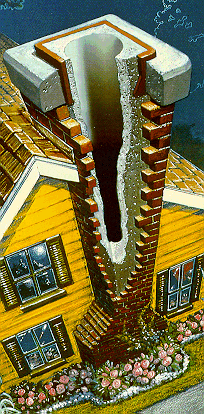flue
A flue is a structure in a residential heating appliance, industrial furnace, or power plant, into which combustion gases flow and are contained until they are released into the atmosphere. There's sometimes confusion between the terms "flue" and "chimney," and they are often used almost interchangeably. Strictly speaking, a chimney is a walled structure that encloses a flue, while the flue itself is the passage that conveys the combustion products. Whereas a chimney is made of brick or stone, a flue can also be made of other materials such as metal. When a flue is made of metal or similar material it is often called a flue pipe.
 |
| A flue inside a brick chimney
|
The outlet of a flue must rise above the roof line in order that combustion products can be dispersed unhindered and without creating a fire hazard. The direction of the flue should be should be straight and vertical where possible. Bends should not exceed 45° to the vertical to maintain natural draft and ease of cleaning, and there should be no more than two bends in a flue. Horizontal runs should be avoided, and in any event must not exceed 150 cm in length. Only one appliance may enter any flue and all flues should be insulated to the build up of creosote and to protect the building against the effects of chimney fires.
